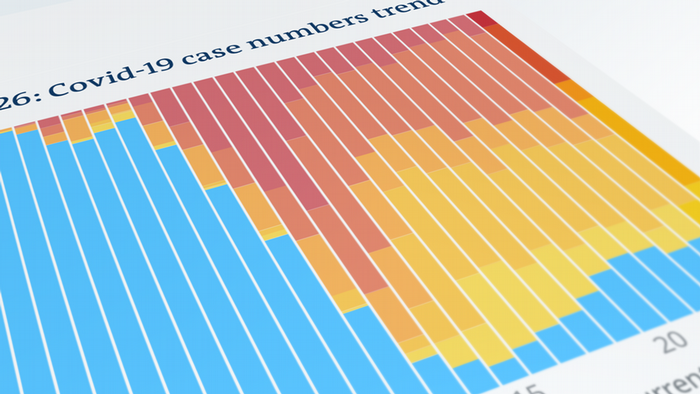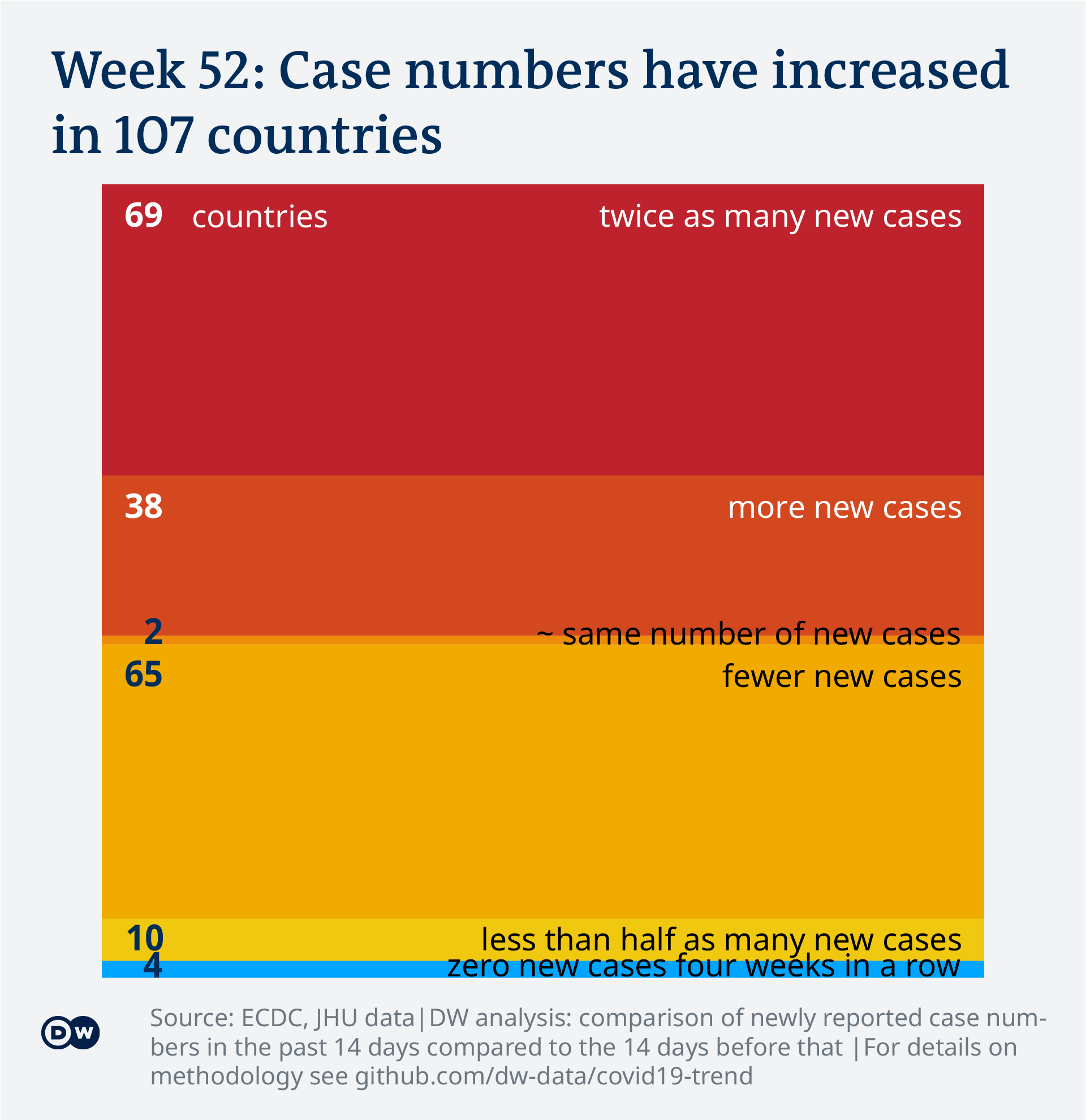The coronavirus pandemic is far from over
Some countries are reporting more new coronavirus infections compared with the previous two weeks. Global data trends show that the pandemic isn't over yet. DW sums up the current situation in three charts.

Case numbers are still rising in many countries
These charts and this article are updated every Friday between 1100 and 1300 UTC. Last updated: December 31, 2021. You can always find this article at dw.com/covid19-trend
What's the current global trend?
The goal for all countries is to make it to the blue section of the chart and stay there. Countries and territories in this section have reported no new cases for four weeks in a row.
Currently, that is the case for four out of 188 countries and territories.

Please note: The number of newly reported cases highly depends on a country's ability to conduct tests and its strategy for administering tests. Additionally, some countries have been criticized for not accurately reporting case numbers.
How has the COVID-19 trend evolved over the past weeks?
The situation deteriorated further: 107 countries have reported more cases in the past two weeks compared with the previous 14 days.

What is the current COVID-19 trend in my country?
Based on the newly reported case numbers — which can reflect local outbreaks as well as nationwide spread — in the past 28 days, countries and territories classify as follows:

More than twice as many new cases:
- Africa: Bahrain, Cyprus, Israel, Kuwait, Oman, Saudi Arabia, United Arab Emirates
- Africa: Angola, Botswana, Burundi, Cape Verde, Cameroon, Comoros, Congo, Democratic Republic of the Congo, Ivory Coast, Djibouti, Equatorial Guinea, Ethiopia, Gabon, Ghana, Guinea, Kenya, Lesotho, Liberia, Madagascar, Malawi, Mauritania, Morocco, Mozambique, Namibia, Nigeria, Rwanda, Sao Tome and Principe, Senegal, Sierra Leone, Somalia, South Sudan, Togo, Uganda, Zambia
- Americas: Antigua and Barbuda, Argentina, Bahamas, Belize, Canada, Dominica, Grenada, Jamaica, Panama, Paraguay, Saint Kitts and Nevis, Saint Lucia, Suriname, United States of America, Uruguay
- Europe: Denmark, Greece, Iceland, Ireland, Italy, Malta, Monaco, Montenegro, Portugal, Spain, United Kingdom
- Oceania: Australia, Fiji
More new cases:
- Asia: Bangladesh, China, India, Japan, Lebanon, Maldives, Pakistan, Philippines, Qatar, Taiwan, Turkey, Palestinian territories
- Africa: Algeria, Burkina Faso, Gambia, Guinea Bissau, Libya, Mali, Niger, Seychelles, Tunisia
- Americas: Bolivia, Colombia, Costa Rica, Cuba, Dominican Republic, Ecuador, Peru
- Europe: Estonia, Finland, France, Kosovo, Latvia, Luxembourg, San Marino, Sweden, Switzerland
- Oceania: Solomon Islands
About the same number of new cases (no change or plus/minus 2%):
- Africa: Egypt
- Europe: Bulgaria
Fewer new cases:
- Asia: Afghanistan, Azerbaijan, Bhutan, Myanmar, Georgia, Indonesia, Iran, Iraq, Kazakhstan, South Korea, Kyrgyzstan, Laos, Malaysia, Mongolia, Nepal, Singapore, Sri Lanka, Syria, Thailand, Timor Leste, Uzbekistan, Vietnam, Yemen
- Africa: Benin, Central African Republic, Chad, Eritrea, Eswatini, Mauritius, South Africa, Sudan, Zimbabwe
- Americas: Barbados, Brazil, Chile, Guatemala, Guyana, Honduras, Mexico, Nicaragua, Saint Vincent and the Grenadines, Trinidad and Tobago, Venezuela
- Europe: Albania, Andorra, Austria, Belarus, Belgium, Bosnia and Herzegovina, Croatia, Germany, Liechtenstein, Lithuania, Moldova, Netherlands, North Macedonia, Norway, Poland, Romania, Russia, Serbia, Slovenia, Ukraine
- Oceania: New Zealand, Vanuatu
Less than half as many new cases:
- Asia: Armenia, Brunei Darussalam, Cambodia, Jordan
- Americas: El Salvador, Haiti
- Europe: Czech Republic, Hungary, Slovakia
- Oceania: Papua New Guinea
Zero new cases:
- Asia: Tajikistan
- Europe: Vatican
- Oceania: Marshall Islands, Samoa
If you have questions regarding the analysis, please refer to the project's Github repository for code and methodology. For feedback regarding the charts, please contact: data-team@dw.com
The charts in this article were inspired by the work of Lisa Charlotte Muth.




No comments:
Post a Comment